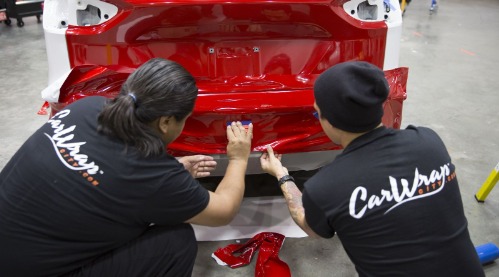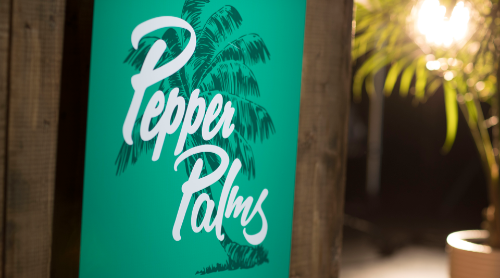Adhesive Vinyl Basics- An Overview
 We may be able to access endless information right at our fingertips thanks to the internet, but where do we begin? When looking at something as broad as vinyl, how do you know which one to use? What types of adhesives are there? Even if you know how long you want your project to last, picking any vinyl will not work because they each come with their own longevity. Becoming a professional on the topic is not easy, but we’ll lay out the basics of adhesive vinyl. In the following article we’ll go over what it’s used for, what types of adhesives you can have, what types of vinyl there are, and the basics to applying vinyl.
We may be able to access endless information right at our fingertips thanks to the internet, but where do we begin? When looking at something as broad as vinyl, how do you know which one to use? What types of adhesives are there? Even if you know how long you want your project to last, picking any vinyl will not work because they each come with their own longevity. Becoming a professional on the topic is not easy, but we’ll lay out the basics of adhesive vinyl. In the following article we’ll go over what it’s used for, what types of adhesives you can have, what types of vinyl there are, and the basics to applying vinyl.It should be noted that adhesive vinyl is different from heat-transfer vinyl (HTV as it is commonly referred to). HTV is vinyl specially made for fabrics and other materials. Adhesive vinyl has a sticky side and a non-adhesive, color side. HTV has a heat-activated backing that has to be cut, weeded, and is used for crafts and custom t-shirt designs. To see more about HTV vinyl and other methods, take a look at our other blogs! We’ll be sticking with adhesive vinyl for this one.
What It’s used for
There is a lot that adhesive vinyl is used for. It has the capability, depending on type, to be used for signs, murals, vehicles, window art or promotion, and much more. Sticking properly to various surfaces is another thing, but matching the right adhesive to the right surface can help your vinyl last. Finding out which adhesive would be best fit for your sticking needs will be discussed later.
Adhesive Types
Or discussed right now. Permanent and Temporary adhesive are what is normally brought up when talking about vinyl, but Cling and Air-Released are more specific types.
Permanent:
Permanent adhesive is meant, you guessed it, to be up for a long time. It’s an adhesive that can typically withstand the harsh outdoors and is tougher to remove. If place on something like a painted wall, it can remove some paint when coming off. It’s used for car decals, sign making, personalized glass or tumblers, and more. Make sure you really like what you’re putting down!
Temporary:
Temporary adhesive is meant to be used not for durability and more for removeable and repositionable. It can be moved with little residual residue and repositioned easily. More aggressive removable adhesives might need some help from a heat fun or hairdryer to come off. It can also last a long time, but cannot hold up against outdoor weathering like Permanent adhesive. While this type can be used for decals or signs, it’s typically used for wall decals or murals, among other things.
Air-released:
Air-released is designed with cars in mind. It is made so air can escape during the installation process and prevents bubbles from forming and keeps the vinyl smooth around all the curves and turns on a car. You’d be hard pressed to find a car graphic vinyl that doesn’t use Air-Release of some kind.
Cling:
Cling adhesive can be found in schools, shops, and stores. It’s easy to apply and leaves no residue upon removal. Cling adhesive is easy to remove and reposition. It sticks will to smooth surfaces like windows, but isn’t the most durable. It’s meant for indoor use and can lose its ability to cling to the surface over time. In some conditions like low temperatures, it may not work at all.

Vinyl types
There are several types of vinyl, but we are focusing on two main vinyl types: Calendered and Cast. The two types of vinyl are distinguished from their creation by how they are made. While the creation of casting is compared to the baking of a cake, calendered vinyl is made more like bread as it is mixed and kneaded and then pushed through a steel roller—a process called calendaring, which is why it is named calendered. (crazy, we know).
Calendered:
This type of vinyl is considered more temporary (even though permanent calendered can last up to seven years). Its longevity and durability are dependent on the grade of vinyl. It’s a stiffer and thicker film and makes it easier to handle. Calendered vinyl does well on flat surfaces as well as simple to moderate curves. It has a high resistant to abrasion and is consider to be more economical to cast film. It’s recommended to be used for projects like sun shade visors, window decals, wall art, labels, and floor graphics.
Cast:
This type of vinyl is considered more permanent. Cast is considered the industry premium. It has extended life and durability, lasting seven years and beyond with the right conditions. Cast vinyl is thinner, and easier to conform to substrates with complex curves and still have a smooth finish. The colors of cast film maintain better than calendered and the finishes last longer too. These films are also produced in small batches and you can get a wider variety of color and finishes as opposed to calendered vinyl. Cast vinyl is recommended for vehicle wraps and architectural wraps (i.e.: cabinets), but can be used for concrete and textured surfaces.
Basics to Applying Adhesive Vinyl:
Now that we’ve discussed the types of vinyl, how do you apply it? If you want to get the vinyl to adhere properly and last, you want to make sure you are doing and avoiding several things. To make vinyl adhere you want a clean, dry, and smooth surface. The cleaner, harder, and shiner the surface the better off you will have with your vinyl sticking. Prep the surface first with rubbing alcohol and allow it to dry. Avoid using cleaners with ammonia because it will decorate the adhesive and cause the vinyl to malfunction. Textured surfaces are not ideal, but special vinyl is made for those surfaces.
After giving you a beginner look to vinyl, we hope you find yourself more knowledgeable on the subject. If you want to inquire more about vinyl and how to utilize it in your next project, give us a call and ask one of our knowledgeable reps at 800-253-1569 or go to Wensco.com to discover our array of vinyl’s.


